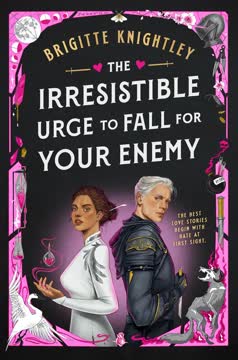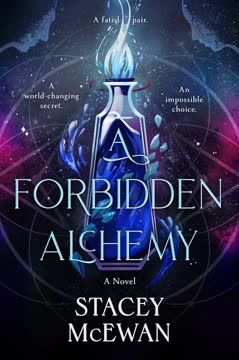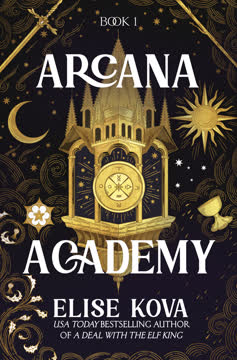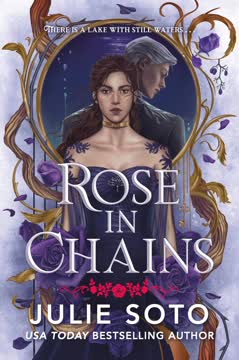Plot Summary
A Door Turns Black
Twenty years ago, Saffron Killoran's life is shattered when two Bloodmoon enforcers murder her parents in their enchanted home, seeking a necromancer. Hidden in a magical pantry, Saffron survives, traumatized and mute for years. The Killorans' home, once a haven of whimsy and love, becomes a tomb. The event brands Saffron with a singular purpose: to infiltrate the Bloodmoons and avenge her family. The trauma of that night, the color-changing door, and the scent of honeywine and ash, become the foundation of her identity. This loss, and the knowledge that pleasure and pain fuel magic, will shape every choice she makes, setting her on a path where grief is both her burden and her power.
The Final Assessment
Years later, Saffron stands on the brink of becoming a Silvercloak, Vallin's elite magical detective force. Alongside her close-knit cohort—Auria, Nissa, Tiernan, Sebran, and Gaian—she faces a final assessment: a simulated hostage crisis in a temple, complicated by magical handicaps and personal rivalries. Saffron, hiding her immunity to magic and her forged credentials, must outthink her peers. The test devolves into chaos, revealing fractures in the group and Saffron's willingness to bend rules for others. Her use of rare spells and mattermancy, and her ability to freeze time, set her apart. The assessment's aftermath is marred by suspicion and silence, but Saffron's determination to become a Silvercloak—no matter the cost—remains unbroken.
Silvercloak's Secret
Saffron's acceptance into the Silvercloaks is shadowed by her secret: she is immune to magic, unable to be enchanted or healed, and her Enchanter accreditation is a forgery. Only Captain Aspar, her commanding officer, knows the truth, but keeps Saffron for her unique skills and a debt owed to Saffron's father. Saffron's relationships with her cohort are complex—Auria's optimism, Nissa's fiery independence, Tiernan's fragility. The group's bonds are tested by ambition, love, and the looming threat of limited job postings. Saffron's singular focus on avenging her parents isolates her, but also makes her invaluable. The cost of her deception grows heavier as she is chosen for a deep undercover mission: to infiltrate the Bloodmoons and bring them down from within.
The Bloodmoon Gamehouse
To earn the Bloodmoons' trust, Saffron must destroy her own reputation, endure prison, and gamble away everything in a notorious gamehouse. The city of Atherin, vibrant and hedonistic, is shadowed by Bloodmoon violence and addiction. Saffron's immersion in the gamehouse reveals the seductive power of loxlure, a magical narcotic, and the cruelty of Bloodmoon justice. She witnesses torture, death, and the transformation of pleasure into a weapon. Her own immunity to magic becomes both a shield and a liability. The gamehouse is a microcosm of the city's corruption, and Saffron's first steps as a Bloodmoon are marked by pain, humiliation, and the knowledge that she is now truly alone.
The Kingpin's Son
Saffron's initiation into the Bloodmoons is overseen by Levan Celadon, the kingpin's enigmatic son. Their relationship is fraught with suspicion, violence, and a strange, growing intimacy. Levan is both torturer and protector, marked by his own scars and a haunted past. Saffron endures the agony of the Bloodmoon brand, a magical mark meant to ensure loyalty, but her immunity renders it powerless. She is forced to kill, to betray her own morals, and to navigate the treacherous politics of the Bloodmoon compound. Levan's complexity—his intelligence, his pain, his longing for something lost—mirrors Saffron's own. Their fates begin to entwine, even as they circle each other as predator and prey.
The Brand and the Betrayal
Saffron's life as a Bloodmoon is a constant negotiation between her true self and the role she must play. She is forced to kill an innocent croupier to prove her loyalty, and endures the branding ritual that leaves her physically and emotionally scarred. The brand, meant to ensure obedience, is powerless against her, but the pain is real. Saffron's immunity is both her greatest asset and her deepest secret. She must balance the need to gather evidence for the Silvercloaks with the daily threat of exposure and death. Her relationships—with Levan, with her former cohort, with her own past—are tested to the breaking point as she is drawn deeper into the Bloodmoon web.
Undercover Among Enemies
Saffron's undercover mission intensifies as she navigates the Bloodmoons' criminal empire. She uncovers the loxlure operation, witnesses the kingpin's sadistic control, and is forced to manipulate both her enemies and her former friends. Her immunity to magic allows her to survive where others would perish, but it also isolates her. The lines between loyalty and betrayal blur as she forms a reluctant bond with Levan, who is himself trapped by family, power, and pain. Saffron's actions have consequences—innocents die, friends are endangered, and her own soul is eroded by the choices she must make. The mission becomes not just about revenge, but about survival and the search for meaning in a world built on pain.
The Prophecy's Kiss
A vision from a relic wand haunts Saffron: she is fated to kiss—and kill—a Bloodmoon. As her relationship with Levan deepens, desire and dread intertwine. Their intimacy is both a weapon and a wound, each seeking solace in the other's brokenness. The prophecy becomes a self-fulfilling curse, shaping their actions and choices. Saffron's longing for connection wars with her need for vengeance. The boundaries between love and hate, trust and betrayal, blur until they are indistinguishable. The kiss, when it comes, is both an act of hope and the harbinger of ruin, setting in motion the final unraveling of their fates.
The Loxlure Conspiracy
Saffron uncovers the Bloodmoons' true source of power: the loxlure trade, a magical narcotic that enslaves the city's population. The operation is vast, insidious, and protected by corruption at the highest levels. The Silvercloaks' attempts to raid the Bloodmoons are foiled by betrayal from within and Levan's cunning. Saffron's own experience with loxlure addiction reveals the seductive danger of pleasure as power. The city's suffering becomes personal, as friends and innocents are caught in the crossfire. The conspiracy is not just criminal, but existential—a war for the soul of Atherin, and for Saffron's own.
The Necromancer's Price
Desperate to save a friend, Saffron seeks out a necromancer, only to discover the true cost of defying death. The Risen are hollow, stripped of pleasure and pain, their magic forever lost. The Bloodmoons' obsession with necromancy is revealed to be rooted in grief and denial—Levan's quest to resurrect his mother, the queenpin, is the engine of their cruelty. Saffron's own attempts to undo death are fraught with failure and unintended consequences. The boundaries between life and death, past and present, are blurred by magic, pain, and longing. Every act of resurrection is a bargain with darkness, and the price is always too high.
The Timeweaver Revealed
Saffron discovers her true nature: she is a Timeweaver, the last of a magical line thought extinct. Her immunity to magic is the key to her power, and the reason for her survival. With the help of a weaverwick wand and a golden hourglass, she learns to unmake and remake moments in time. The revelation is both a gift and a curse, offering the possibility of undoing tragedy but at the risk of unraveling reality itself. The Bloodmoons' obsession with ascenite, the magical amplifier, is revealed to be a desperate attempt to fuel timeweaving and resurrect the dead. Saffron's power becomes the fulcrum on which the fate of the world balances.
The Havenwood Trap
The Bloodmoons, lured to Levan's childhood home in the Havenwood, are trapped by the Silvercloaks' perimeter dome. The past and present collide as old wounds are reopened and new betrayals are forged. Saffron, torn between her mission and her love for Levan, must choose between saving herself, her friends, or the man she has come to care for. The battle is brutal, marked by loss, sacrifice, and the shattering of illusions. The cost of pain, the power of pleasure, and the limits of loyalty are all tested as the world teeters on the edge of unmaking.
A Fate Unwritten
In the aftermath of the battle, Saffron faces the consequences of her choices. The prophecy is fulfilled—she kisses and kills Levan, but the cost is unbearable. Friends are dead, the mission is in ruins, and Saffron is left with nothing but grief and regret. Desperate, she uses her timeweaving power to unmake the night, to try again, to save those she loves. Each attempt is marked by pain, loss, and the realization that some fates cannot be escaped. The world becomes a palimpsest, rewritten and rewritten, but the scars remain. Saffron's power is both her salvation and her damnation.
The Cost of Pain
Every act of timeweaving exacts a terrible price. Saffron's body and soul are ravaged by the pain she must endure to fuel her magic. The saqalamis, a device of pure agony, becomes her last resort. The boundaries between self and suffering blur, and Saffron is forced to confront the darkness within herself. The cost of survival is the loss of innocence, the erosion of hope, and the knowledge that every victory is built on a foundation of pain. The world she is trying to save is one she can barely recognize, and the person she has become is both hero and villain.
The Golden Hourglass
With the power to rewrite history in her grasp, Saffron is faced with an impossible choice: to accept the world as it is, or to risk everything to undo the past. The golden hourglass, the weaverwick wand, and the fallowwolf are the keys to her power, but also the instruments of her potential undoing. The temptation to save her parents, to erase all the pain and loss, is overwhelming. But every act of unmaking has consequences, and the line between savior and destroyer grows ever thinner. Saffron stands at the threshold of godhood, haunted by the knowledge that villains are born from the best of intentions.
The Last Betrayal
In the final reckoning, Saffron's love for Levan is both her strength and her undoing. Their fates, braided together by grief and longing, are torn apart by betrayal and necessity. The prophecy is fulfilled, but at a cost neither can bear. The world is left scarred, the survivors broken, and the future uncertain. Saffron's journey from victim to avenger to would-be savior is complete, but the price is everything she once held dear. The story ends not with triumph, but with the knowledge that some wounds can never be healed.
The World Unmade
In the aftermath, Saffron contemplates the ultimate act of timeweaving: to unmake the world, to save everyone she has lost, to undo every tragedy. The temptation is overwhelming, but the cost is the unraveling of reality itself. The story closes with the realization that the line between hero and villain is razor-thin, and that the power to unmake the world is both a blessing and a curse. Saffron's journey is not over, and the world she has remade is forever changed.
Hope and Ruin
In the epilogue, Levan, now kingpin, reflects on all that has been lost and all that has been unmade. He recognizes Saffron's power, her betrayal, and the inevitability of their intertwined fates. The story ends with the promise that hope and ruin are two sides of the same coin, and that the struggle to shape destiny is never truly over. The world is left poised between salvation and destruction, and the next move belongs to those who dare to unmake fate itself.
Characters
Saffron Killoran
Saffron is the heart of the story—a survivor of childhood trauma, forged by the murder of her parents into a weapon of vengeance and cunning. Her immunity to magic, a rare and isolating gift, shapes her identity and her path. Saffron is fiercely intelligent, adaptable, and willing to bend or break rules for those she loves. Her relationships are marked by longing and loss: she is both protector and betrayer, lover and enemy. Her psychological complexity is rooted in grief, guilt, and the desperate need for meaning. As a Timeweaver, she is both savior and potential destroyer, her power a double-edged sword. Saffron's journey is one of self-discovery, sacrifice, and the realization that the line between hero and villain is perilously thin.
Levan Celadon
Levan, the kingpin's son, is a study in contradictions: torturer and healer, victim and perpetrator, lover and betrayer. Scarred by childhood loss and years of pain, he is driven by the impossible quest to resurrect his mother. His magical prowess—encompassing healing, wielding, enchanting, and compelling—is both a gift and a curse, honed by torture and necessity. Levan's relationship with Saffron is fraught with suspicion, longing, and the shadow of prophecy. He is both Saffron's mirror and her opposite, their fates braided together by grief and hope. His struggle for control, his capacity for both cruelty and tenderness, and his ultimate betrayal by those he loves define his tragic arc.
Captain Elodora Aspar
Aspar is the Silvercloak captain, a Wielder of immense power and unwavering conviction. Her devotion to the Augurest prophecies and her own moral code make her both a mentor and a judge. She is the only one who knows Saffron's true nature and keeps her in the Order out of a debt to Saffron's father. Aspar's leadership is marked by pragmatism, ambition, and a willingness to sacrifice individuals for the greater good. Her death is both a personal and institutional loss, and her legacy is the question of whether the ends ever justify the means.
Nissa Naszi
Nissa is Saffron's former lover and a Wielder of fire, marked by her Eqoran heritage and rumored dragonblood. She is both a source of strength and vulnerability for Saffron, their relationship defined by passion, secrecy, and the refusal to be tamed. Nissa's independence and resilience make her a formidable ally, but her pain and addiction are ever-present shadows. Her fate—caught between life and death, loyalty and survival—mirrors the story's central tensions.
Auria Marriosan
Auria is the cohort's moral compass, a prodigy with multiple magical classifications and an unshakeable belief in goodness. Her optimism is both a comfort and a liability, blinding her to the darkness in others and herself. Auria's relationships—with Saffron, Tiernan, and her own family—are tested by betrayal, loss, and the demands of justice. Her grief and anger in the story's climax reveal the cost of idealism in a broken world.
Tiernan Flane
Tiernan is the cohort's gentle soul, haunted by an abusive father and a desperate need for approval. His weakness makes him vulnerable to Bloodmoon manipulation, and his betrayal is both tragic and inevitable. Tiernan's love for Auria and his friendship with Saffron are sources of hope, but his inability to withstand pressure leads to his downfall. His death is a turning point, forcing Saffron to confront the limits of her own power and the consequences of her choices.
Lyrian Celadon
Lyrian is the Bloodmoon kingpin, a man whose memory is his greatest weapon. He is both puppet and puppeteer, driven by grief for his wife and the need to control every thread of the city. His relationship with Levan is marked by violence, regret, and the inability to break free from the past. Lyrian's actions are both monstrous and pitiable, and his death is the end of an era—and the beginning of another.
Segal
Segal is one of the Bloodmoon enforcers who killed Saffron's parents, later resurrected as a Risen—stripped of pleasure, pain, and magic. His transformation is a living death, a warning of the cost of defying nature. Segal's presence is a constant reminder of Saffron's trauma and the futility of revenge. His fate is both justice and tragedy, a symbol of the story's moral ambiguity.
Nalezen Zares
Zares is the elusive necromancer whose power is both coveted and feared. Her actions—raising the dead, bargaining for freedom—are driven by self-preservation and a twisted sense of purpose. Zares is both victim and villain, her presence forcing Saffron and Levan to confront the limits of magic and the price of resurrection. She is the key to the Bloodmoons' ultimate goal and the embodiment of the story's darkest temptations.
Rasso
Rasso, the magical fallowwolf, is both companion and symbol. Once bonded to Levan's mother, he becomes Saffron's ally through the power of timeweaving. Rasso's presence marks the intersection of past and present, magic and memory. He is a creature of instinct, loyalty, and the mysteries of time, guiding Saffron through the story's most perilous moments and reminding her of the cost—and possibility—of change.
Plot Devices
Duality of Pain and Pleasure
The world of Silvercloak is built on the principle that magic is powered by both pleasure and pain—pleasure replenishes the well, pain sharpens its potency. This duality is not just a system of magic, but a metaphor for the human condition: every act of creation or destruction is rooted in feeling. The narrative uses this device to explore trauma, addiction, and the cost of power. Characters seek pleasure to heal and pain to survive, blurring the lines between self-destruction and self-preservation. The interplay of pain and pleasure is mirrored in relationships, choices, and the very structure of the plot, where every victory is paid for in suffering.
Timeweaving and Narrative Structure
Timeweaving is both a magical ability and a narrative device, allowing the story to explore alternate timelines, the consequences of choices, and the temptation to unmake the world. Saffron's discovery of her power enables the plot to loop, rewind, and branch, creating a palimpsest of realities. This structure heightens suspense, deepens character development, and foregrounds the theme of agency versus destiny. The use of timeweaving raises questions about the ethics of power, the nature of regret, and the impossibility of escaping one's own story.
Prophecy and Self-Fulfilling Fate
The prophecy that Saffron will kiss and kill a Bloodmoon is a classic device of foreshadowing, shaping characters' actions and the reader's expectations. The vision becomes a self-fulfilling curse, driving Saffron and Levan toward their doomed intimacy. The story interrogates the nature of prophecy: is fate written, or do attempts to avoid it only ensure its fulfillment? The tension between foreknowledge and free will is a central engine of the plot, culminating in the realization that the power to unmake fate is itself a kind of trap.
Undercover Identity and Moral Ambiguity
Saffron's double life as a Silvercloak and a Bloodmoon is a vehicle for exploring the costs of deception, the fluidity of identity, and the moral ambiguity of survival. The narrative structure—alternating between loyalty and betrayal, love and hate—mirrors Saffron's internal conflict. The use of undercover work as a plot device allows for shifting alliances, unexpected betrayals, and the constant threat of exposure. It also foregrounds the psychological toll of living a lie, and the question of whether the ends ever justify the means.
The Sunk Cost Fallacy
Throughout the story, characters are driven by the need to justify past sacrifices—Saffron's quest for vengeance, Levan's pursuit of resurrection, the Bloodmoons' accumulation of ascenite. The narrative uses the sunk cost fallacy as a plot device, showing how the refusal to abandon a doomed course leads to greater and greater losses. This device is both a source of suspense and a commentary on the human tendency to double down on failure, even when the price becomes unbearable.
Analysis
Silvercloak is a masterful exploration of trauma, power, and the perilous allure of rewriting fate. At its core, the novel interrogates the cost of survival in a world where magic is fueled by the extremes of pleasure and pain, and where every act of healing or harm leaves a mark on the soul. Saffron's journey—from orphaned survivor to undercover agent, from avenger to would-be savior—mirrors the reader's own struggle to reconcile hope and ruin, love and betrayal. The story's use of timeweaving as both a magical system and a narrative structure allows for a profound meditation on regret, agency, and the ethics of unmaking the past. The characters are richly drawn, their relationships fraught with longing, loss, and the ever-present threat of becoming the very thing they hate. Silvercloak ultimately asks: can we ever truly escape the scars of our history, or does the attempt to undo pain only create new wounds? The novel's refusal to offer easy answers, its embrace of moral ambiguity, and its willingness to let its heroine become both hero and villain make it a resonant, unforgettable work for a modern audience.
Last updated:
Review Summary
Silvercloak received mixed reviews, with ratings ranging from 1 to 5 stars. Positive reviews praised the unique magic system, world-building, and compelling characters. Many found the plot engaging and full of unexpected twists. Critics noted issues with pacing, character development, and repetitive writing. Some felt the book leaned more towards young adult than adult fantasy. The romance subplot garnered both praise and criticism. Overall, readers appreciated the creative concept but were divided on its execution.
Silvercloak Saga Series
Similar Books
Download PDF
Download EPUB
.epub digital book format is ideal for reading ebooks on phones, tablets, and e-readers.









